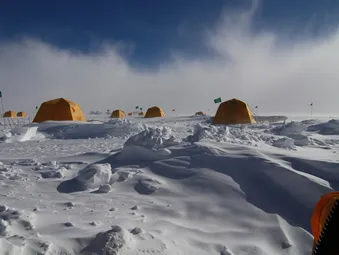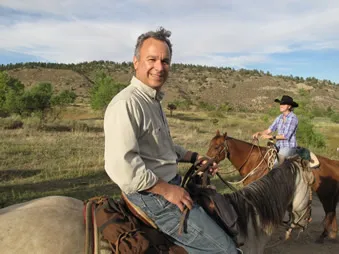By Jane Beitler
On September 21 to 23, more than 90 Antarctic scientists, data experts, writers, and students gathered at Sylvan Dale Ranch, nestled in the rolling plains near Loveland, Colorado. This three-day retreat brought diverse research disciplines from around the world to focus on rapid changes in the West Antarctic Ice Sheet (WAIS) and related areas of other ice caps.
Unlike most of the ice in Antarctica, the West Antarctic Ice Sheet rests on bedrock below sea level. In the 1970s, theoretical research suggested this made it vulnerable to a rapid collapse, potentially as quickly as two centuries, that could add several meters to sea level. NASA researcher Bob Bindschadler said, “This research suggested that ice sheets were not stable if they sat on a bed below sea level.” Once the ice sheet began to retreat, water would flow under it, lifting the ice and floating it off its resting place.
Research on the WAIS started off with glacier studies, but researchers soon realized that there were more factors involved. “As the science evolved, we realized it wasn’t just a glaciological problem. There were additional aspects of the science that involved meteorology and oceanography and ice coring subglacial geology,” said Bindschadler. The researchers needed to measure and monitor such things as whether the ice sheet was gaining or losing mass, whether glaciers were speeding up their flows, and how much these changes were adding to sea level.
An interdisciplinary community
Each year, scientists meet at the workshop to share the latest WAIS research, and mull over difficult questions like how the valleys and lakes underneath the ice sheet affect how it moves, or what happens to glaciers when the ice shelves in front of them collapse. NSIDC Lead Scientist Ted Scambos organized the workshop this year along with NSIDC and CIRES staff. He said, “The WAIS meeting is the key meeting of the year for ice sheet dynamics, remote sensing, and the net growth or shrinkage—mass balance—of the WAIS and other major ice sheets.”
This year, researchers presented new data that helps better quantify just how much ice is trapped in the giant ice sheet, how fast it is moving, and where it is going. Researchers from UC Irvine presented a new, virtually complete map of ice velocity across Antarctica, showing where the ice is flowing fastest. Scientists also discussed how to best harness data from the NASA Gravity Recovery and Climate Experiment (GRACE) satellite to measure the mass of the ice sheet, and determine how that data might fit together with new data from the European Cryosat mission and the upcoming Ice, Cloud, and Land Elevation Satellite–2 (ICESat–2).
New radar studies presented detailed maps of the lakes and rivers that flow beneath the ice sheet. Christine LeDoux, a researcher at Portland State University, attended the workshop for the first time this year. She said, “The length of the meeting and social opportunities made it possible to talk with many people, working on different parts of problems similar to mine, or interesting in different ways.” LeDoux presented details of the history of ice flow and fracturing on the Ross Ice Shelf using MODIS mosaic images. As observations of West Antarctica improve, the scientists are realizing that it’s more important than ever to continue the meeting. Bindschadler said, “We have been astonished at how rapidly changes can occur. We are no longer talking about hypothetical dynamics of the ice sheets, but we are perhaps witnessing the early stages of this.”

